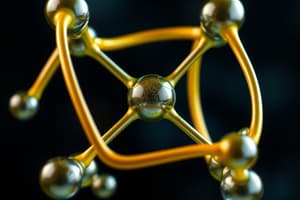Podcast
Questions and Answers
Which of the following atoms is least likely to form an ion?
Which of the following atoms is least likely to form an ion?
- Sodium
- Neon (correct)
- Magnesium
- Fluorine
Which of the following elements is most likely to lose an electron to become a cation?
Which of the following elements is most likely to lose an electron to become a cation?
- Chlorine (Cl)
- Iron (Fe) (correct)
- Arsenic (Ar)
- Carbon (C)
If the name of an ion ends in -ate, what type of ion is it most likely to be?
If the name of an ion ends in -ate, what type of ion is it most likely to be?
- A polyatomic cation
- A monatomic anion
- A monatomic cation
- A polyatomic anion (correct)
Which of the following is true about elements that exist as diatomic molecules?
Which of the following is true about elements that exist as diatomic molecules?
Nitrous Oxide has the formula N2O. What is the proper chemical name?
Nitrous Oxide has the formula N2O. What is the proper chemical name?
What is the name of NO2?
What is the name of NO2?
What is the correct chemical name for a compound with the formula N2O3?
What is the correct chemical name for a compound with the formula N2O3?
What is the systematic name of CS2?
What is the systematic name of CS2?
What is the correct name for XeF4?
What is the correct name for XeF4?
Which of the following is a chemical property of water?
Which of the following is a chemical property of water?
Which of the following is not a physical property of gold?
Which of the following is not a physical property of gold?
The principal quantum number indicates what property of an electron?
The principal quantum number indicates what property of an electron?
What is the shape of the 3p orbital?
What is the shape of the 3p orbital?
How many energy sublevels are in the second principal energy level?
How many energy sublevels are in the second principal energy level?
What is the number of f orbitals in any single energy level in an atom?
What is the number of f orbitals in any single energy level in an atom?
Flashcards are hidden until you start studying
Study Notes
Ion Formation
- Neon is least likely to form an ion due to its stable electron configuration.
- Fluorine, magnesium, and sodium readily form ions.
Electron Loss
- Iron (Fe) is most likely to lose an electron, thus forming a cation among the options provided.
Ion Naming
- An ion ending in -ate is typically a polyatomic anion, indicating a larger group of atoms than monatomic ions.
Diatomic Molecules
- Properties of diatomic molecules include that the type of bond may vary; it can be nonpolar covalent, polar covalent, or ionic, depending on the specific elements involved.
Chemical Naming
- Nitrous Oxide is properly named Dinitrogen oxide, indicated by its chemical formula N2O.
- Nitrogen Dioxide is referred to as Nitrogen dioxide, corresponding to its formula NO2.
- A compound with the formula N2O3 is called Dinitrogen trioxide.
Systematic Names
- CS2 is systematically named Carbon disulfide.
- XeF4 is appropriately named Xenon tetrafluoride.
Properties of Water
- Water reacts violently with sodium, demonstrating a distinct chemical property that differs from physical properties like melting point.
Physical Properties of Gold
- All listed properties of gold, such as characteristic color, density, and electrical conductivity, are considered physical properties.
Quantum Number
- The principal quantum number reveals the energy level of an electron in an atom.
Orbital Shapes
- The shape of the 3p orbital is described as a dumbbell.
Energy Sublevels
- The second principle energy level contains two energy sublevels.
F Orbitals
- Each energy level in an atom can contain up to seven f orbitals, which are present beyond the principal quantum number two.
Studying That Suits You
Use AI to generate personalized quizzes and flashcards to suit your learning preferences.




